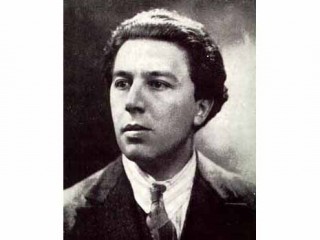
Andre Breton biography
Date of birth : 1896-02-19
Date of death : 1966-09-28
Birthplace : Tinchebray, Orne, France
Nationality : French
Category : Famous Figures
Last modified : 2010-11-28
Credited as : Writer, ,
The French writer André Breton (1896-1966) was the leader of the surrealist movement, which was the most important force in French poetry in the 1920s and 1930s.
André Breton was born in Tinchebray and was studying to be a doctor when he was drafted in 1915. The period of World War I was extremely important for Breton in orienting his career. Already interested in poetry, he met the writers Louis Aragon and Philip Soupault while in the army. Also influenced by meetings with the poets Guillaume Apollinaire and Paul Valéry and the nihilist Jacques Vaché, Breton became interested in the importance of reform and revolt in literature and in society. While in the army Breton was assigned to work in the psychiatric wards. The patients he observed and the study he made of neurology and psychology were, like his personal encounters, of great importance in forming his literary and social theories.
In 1918, together with Aragon and Soupault, Breton brought out the first issue of the review Littérature. And in 1919 Breton's first book of poems, Mont-de-piété (Pawn Shop), appeared. Breton grew progressively more interested in dreams and psychic automatism. By 1924 he had organized a group dedicated to surrealism and had issued his Manifeste du surréalisme. In 1930 and 1934 he wrote two additional manifestos, which explained the principles of surrealism. From the beginning, surrealism was conceived of as a movement transcending the purely literary or esthetic concerns, and it turned increasingly in the direction of social participation. In 1926 Breton joined the Communist party but withdrew in 1935 because of the incompatibility between the total personal freedom that surrealism advocated and the individual submission that Marxism required.
Meanwhile Breton published some of his most important works, notably Nadja, an account of his relationship with a woman and their explorations of the "daily magic" of Paris, and L'Immaculée Conception (The Immaculate Conception), in which Breton and the poet Paul Ãluard simulate various forms of mental derangement. During the rest of the 1930s Breton's chief publication was L'Amour fou (Mad Love), a work illustrating the importance of love, one of the basic articles of surrealist faith. By 1939 it had become apparent that the heyday of surrealism was over. Breton had been its life and soul, but the history of the movement had been marked by noisy repudiations and denunciations. After breaking with his former companions and the Communist party, Breton visited Mexico. He made New York City his headquarters during World War II. When he returned to Paris, existentialism had replaced surrealism, but Breton tried to keep surrealism alive. He organized exhibitions, promoted reviews, and published articles and texts until his death in 1966. Breton's theoretical work continues to have a great impact, and his creative work, although yet not fully appreciated, demonstrates rare poetic gifts.
A recent and thorough biography of Breton is Anna Balakian, André Breton: Magus of Surrealism (1971). J. H. Matthews, André Breton (1967), in the series "Columbia Essays on Modern Writers, " is an introduction by an authority on surrealism. Although older and not as comprehensive, other excellent studies in English are Georges E. Lemaétre, From Cubism to Surrealism in French Literature (1941; rev. ed. 1947), and Anna Balakian, The Literary Origins of Surrealism (1947; rev. ed. 1965) and Surrealism: The Road to the Absolute (1959). Other works are Mary Ann Caws, Surrealism and the Literary Imagination: A Study of Breton and Bachelard (1966), and Herbert S. Gershman, The Surrealist Revolution in France (1969).
















